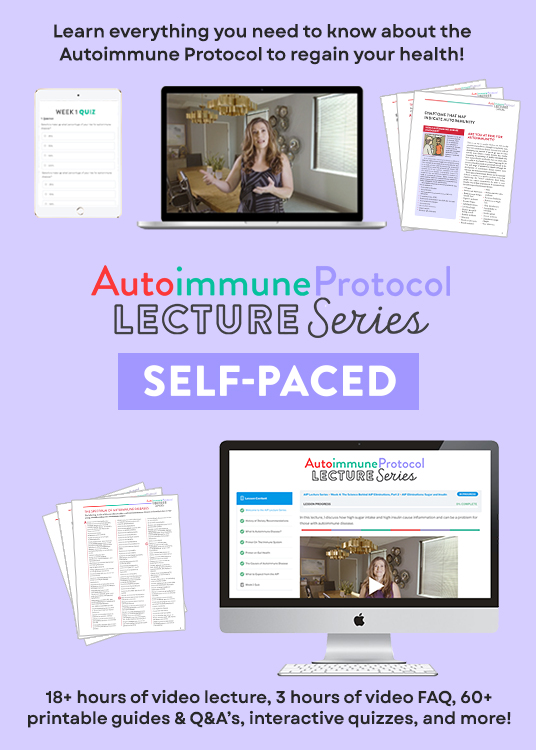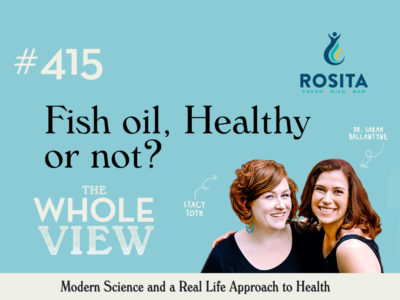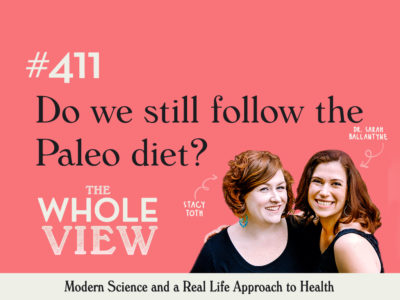Welcome to episode 415 of The Whole View. On this week’s episode, Stacy and Sarah address a listener’s question on fish oil. Is this a supplement you should be taking? How do you find a high-quality brand and what makes a brand high quality? All of this and more below!
If you enjoy the show, please review it on iTunes!
The Whole View, Episode 415: Fish oil, Healthy or not?
Welcome back to the Whole View, episode 415. (0:27)
Stacy is jazzed that they are revisiting a topic that has been laid with controversy for years.
She loves to revisit topics and update science on past episode subjects.
First, Stacy wants to share a story on fish oil.
Stacy recently had an appointment with one of her children who has ADHD/ADD.
The pediatrician knows that they work to manage his symptoms through lifestyle and are trying to avoid medication.
Stacy shared with the pediatrician some of the challenges she has been facing at home and asked if there was an alternative to using a stimulant.
One of the things that he said was to increase the fish oil that this kid was getting, who is on fish oil, but needs to increase his dosage.
A few years ago this is not something they would have heard, so Stacy thought this was a cool advancement.
They will up this child’s intake, and the brand that he takes is Rosita, who is also our sponsor this week.
Save 70% Off the AIP Lecture Series!
Learn everything you need to know about the Autoimmune Protocol to regain your health!
I am loving this AIP course and all the information I am receiving. The amount of work you have put into this is amazing and greatly, GREATLY, appreciated. Thank you so much. Taking this course gives me the knowledge I need to understand why my body is doing what it is doing and reinforces my determination to continue along this dietary path to heal it. Invaluable!
Carmen Maier

We love to showcase brands that we genuinely use and love.
A special thank you to Rosita for being this week’s sponsor.
You can visit them at this link here and use the code ‘thewholeview’ to receive 5% off your order.
Rosita was the brand that made Sarah feel comfortable about taking fish oil again.
Quality is really important, and Rosita‘s fresh cod liver oil (not fermented) is so fresh and wild-caught from sustainable fish.
It is so clean that they don’t even need to add flavoring to it.
This is extra virgin cod liver oil that is top quality and is the brand that Stacy and Sarah choose for themselves and their families.
They offer both the oil and the capsules.
Stacy shared a fun fact about the Rock’s cod intake.
Listener Question
Katie says, “Hi ladies, thank you for your wonderful podcast. (9:55)
I listen every week, and I love everything, from the science to the soapboxes.
My question has to do with fish oil.
Specifically, I’ve heard mixed research on whether or not it is healthy for people to take as a supplement.
It seems there is a lot of people that say that adding a fish oil supplement is really beneficial, but I recently attended a lecture where they were talking about how it can be damaging to the cells due to how it is extracted, and that we actually don’t need it as much as we thought.
As with anything diet and nutrition-related, there always seem to be many camps that people fall into, and I would love to hear your balanced approach on the science!”
DHA & EPA
Let’s start by talking about what it is in fish oil that is the reason it is so recommended. (11:25)
It really has to do with these two different fatty acids, they are the long-chain omega-3 fatty acids, that you have seen as EPA and DHA.
These fatty acids are really important in the body.
They are different from the other main omega-3 that is what we get from chia seeds and flaxseeds, which are abbreviated as ALA.
There are few processes in our body that use ALA, but most of what our body needs are DHA and EPA.
If we are getting our omega-3 from plant sources, our body has to convert the ALA into these longer-chain omega-3’s in order for them to do their function.
This conversion is very inefficient.
When we are counting our omega-3 intake, we should only count the long-chain omega-3’s.
The main food source that we are getting those from is fish and shellfish.
It is really important for our bodies because they are used for forming fat-based hormone-like molecules in our bodies.
Sarah explained these signals in greater detail.
Messenger Molecules
There are three main classes of these molecules that are formed from EPA and DHA. (14:25)
Prostaglandins, thromboxanes, and leukotrienes are classes of messenger molecules produced by many cells throughout the body that are important mediators of a variety of functions, including inflammation.
We want to have the balance between the omega-6’s and omega-3’s in the cell membrane so that the cells can self regulate what type of signal they are producing.
Sarah explained the way that inflammation serves as the starting point for most chronic illnesses.
What we want is to have a balance in our cells so that our immune system can be regulated.
Prostaglandins have essential roles in a variety of systems in the human body, including regulators of blood clotting, pain signaling, cell growth, kidney function, stomach acid secretion, and inflammation.
Thromboxanes are produced by platelets and serve an essential function in blood clotting by simultaneously causing platelet aggregation and vasoconstriction.
Leukotrienes are primarily synthesized by inflammatory cells and are essential mediators of inflammatory and immune reactions.
The Microbiome Impact
Omega-3’s are also really important for the microbiome. (20:05)
There is this whole separate mechanism of how omega-3’s are impacting our health.
What is really interesting about the gut microbiome is that it is much more complicated than just how much fiber we are consuming.
Our gut bacteria also have essential fats, and need those fats to make their cell membranes.
They have signaling that can change their metabolism.
In addition, they are sensitive to the types of proteins we are consuming.
It is far more complex than, just eat fiber.
One of the things that is really important for supporting a healthy community of gut bacteria is omega-3 fats.
Omega-3’s are the most gut-friendly fat that we could eat.
They are particularly sensitive to DHA and EPA.
There are a variety of studies that have shown that with supplementation of fish oil that it does things like improve gut-barrier health, reduces gut inflammation, reduces the production of endotoxin, and helps to drive the growth of important probiotic bacteria.
What is amazing, is that there have been studies in humans where is all they have done is add a fish oil supplementation.
These studies showed that this can correct gut dysbiosis in a very short period of time.
The time markers in these studies range from two to six weeks.
They show a healthier gut microbiome composition, including high diversity, which is one of the most important hallmarks of a gut microbial community.
These are very compelling studies.
Chronic Disease Link
Sarah would never (in eating for gut health) simplify it that we need to simply take a fish oil supplement. (23:04)
There is obviously a lot more to it.
We want to be eating the quality protein, a high diversity of vegetables and fruits, we want to be thinking of mushrooms as their own food group, etc.
This is probably a secondary layer of mechanisms on tops of why omega-3’s (EPA and DHA) are so important for our overall health.
It also explains why not having enough EPA and DHA is linked to chronic disease risk.
Sarah noted that when you look at the layer of benefits, it is a really good way of emphasizing the importance of this nutrient.
On a related note, Sarah took a moment to share her feelings on the essential and non-essential nutrient labels.
The Science
We have this huge collection of studies that are linking higher dietary omega-3s or the amount in our blood cell membrane. (29:07)
Studies that have looked at human health in relation to omega-3’s have shown over and over again that the higher the omega-3’s the lower the risk of chronic illness.
The strongest signals are diabetes and cardiovascular disease.
Supplementation with encapsulated fish oil or fortified foods improves a wide range of cardiovascular risk factors including lipid profile, blood pressure, heart rate and variability, platelet aggregation, endothelial function, and atherosclerotic plaque stability.
We have this huge collection of studies showing that high omega-3’s has all of these outcomes.
So where does the controversy come from?
How common is a deficiency?
Sarah highly recommends reading Death by Food Pyramid by Denise Minger. (34:33)
It is a fascinating story of how the dietary recommendations became lobbyist driven as opposed to science-driven.
This is what has basically colored US dietary guidelines.
Less than 10% of people choose their food based on those guidelines.
Stacy referred listeners back to this podcast episode.
Even though the American Heart Association has targets for omega-3’s, it is not something that most people are even paying attention to.
The adequate intake is considered a bare minimum.
For adult women, the recommendation is 1.1 grams daily.
And for adult men, it is 1.6 grams of omega-3’s daily.
Studies have shown that on average American adults are consuming .4 grams per day from foods and .7 grams from supplements.
Even though people are getting more omega-3’s than they use to, which is predominantly driven by the fish oil supplement industry, most American adults are not meeting the recommendations.
It is still more telling to look at the omega-3 index and look at how much omega-3’s are actually in our cell membranes.
The ideal intake of omega-3’s is relative to the intake of omega-6’s.
So it is really relative to the whole diet, which will vary based on your sources of omega-6’s as well as total fat.
What we want is more omega-3 in our cell membranes.
Studies that have looked at the omega-3 index of culture globally and compare different areas of the world in terms of how we are doing – show that in America our omega-3 index is 4.
This means that the amount of DHA and EPA in our cell membranes is 4% of total fatty acids.
In areas of the world where they are consuming a lot more fish that range is typically between 8 and 15%, and somewhere in that range is healthier.
Even with fish oil supplementation being really common, we are looking at about 70% of people not getting enough EPA and DHA.
Racial Disparities
There are some racial disparities in terms of the likelihood of lower omega-3 index (40:34)
In America, people of Asian descent tend to have the highest omega-3 index.
Whereas people of Hispanic cultural descent, tend to have the lowest, with their average at 3.6%.
This is an area where Black-Americans do a little bit better than white-Americans.
Black-Americans are at about 4.5%, whereas white-Americans are at 3.8%.
Studies have shown that ethnicity does not change how the omega-3’s relate to markers of inflammation.
So how much inflammation there is, is directly related to how many omega-3’s there are.
There are no additional layering of complexity with ethnicity.
Stacy asked a question about how/if stress plays into needing more omega-3’s.
Sarah responded with a yes and explained a bit about this two-way stress.
Quality Matters
Back in 2012, there was this growing number of studies that were showing conflicting information in terms of long-term fish oil supplementation. (44:24)
So what studies were starting to show that over the short-term you could see if you gave somebody fish oil supplementation, that their cardiovascular disease risk factors decreased.
Once you hit the six to eight weeks (some studies showed 12), you would start to see this increase in lipid peroxidation.
This is the oxidative degradation of fat molecules in the body, which is associated with a whole pile of disease processes.
Over time, even though triglycerides would stay low, you would start to see this increase in markers of lipid peroxidation.
There were animal studies where they would give fish oil-enriched diets over a year or two years to mice, showing that fish oil mice lived a shorter amount of time.
At the time, Chris Kresser brought up the issue of oxidation.
In the last few years, this is exactly where scientists have landed on the simplest explanation for this effect.
Sarah explained why these fats are prone to oxidation.
When oxygen does react with a fat, it creates all of these oxidized fat molecules that are problematic and inflammatory.
There is a huge amount of scientific literature, at least in animal studies, showing that consuming oxidized fats or having a process in the body where fats are being oxidized, is bad.
How common are oxidized supplements?
What we found is that studies over the last few years have started looking at how much of these fish oils that are on store shelves are oxidized. (48:07)
There are levels that are considered acceptable.
Studies have shown that it is very problematic.
Over the counter fish oil supplements, depending on the study, show that anywhere between 11 and 80% of the products are oxidized.
There was a study done in American fish oil products that showed that 27% had more than double the level of damage oxidized fats than what was considered an acceptable limit.
Stacy asked if these companies know their products are oxidized?
This is exactly why Stacy and Sarah are very particular about vetting brands.
It is very important that we research this information and advocate for ourselves.
Sarah thinks this problem is more about a lack of awareness in this industry that this is an issue.
Since the chemical structure of these fats are easily oxidized, they need to be extracted under ideal conditions.
And on top of that, they need to be bottled and stored properly.
The things that drive oxidation of fish oil are higher temperatures, exposure to oxygen, light, the presence of water, and the presence of heavy metals.
Oxidation is a snowball effect.
It is really important that the fish oil you are consuming is extracted under conditions that will not damage that fat.
Stored under conditions that will not damage that fat.
It is important to understand that some of the damage can happen after it leaves the factory.
Closing Thoughts
If you are taking a fish oil that does not fall into where you would like it to be, please understand that we are not here to shame you or make you feel bad. (57:15)
There is nothing that ‘shoulds’ will do for you.
We are here to help you feel more informed so that you can make decisions based on easily accessible science.
The good news is that switching to a higher quality fish oil can have profound effects going forward.
This is one of those things that you can change and see improvement in going forward.
There is no reason to feel badly about what you may or may not have been doing in the past.
If you decide that you want to start taking higher quality fish oil, feel good about that decision and leave everything else in the past behind.
One of the things that was really eye-opening to Sarah when doing research for this show, was that her diet (which does incorporate seafood at least daily) still requires a bit of supplementation.
Sarah was looking at it from the omega-6’s vs. omega-3’s intake lens.
Stacy shared a bit on their seafood intake and the way that it tends to ebb and flow with seasons.
Her favorite way to consume seafood right now is by putting anchovies on Ceasar salad.
This has been her go-to lunch during quarantine.
Don’t forget, you can shop at Rosita, and use the code ‘thewholeview’ to get 5% off your order.
We love hearing from you!
Don’t forget, if you liked this podcast, please comment and share.
If you haven’t recently left a review, please take a moment to leave one.
And, if you didn’t yet check out Patreon, we are officially up and running.
There is behind the scenes, not rated-G content there.
Something special will be up for you if you do join.
And special thank you to those who have already signed up.
Your support is amazing!
If you want more of that, go and check that out here.
Thank you so much Sarah for all of the science!
We will of course be back again next week!
If you have more topics that you would like us to discuss, please feel free to submit those ideas using our contact forms.
Thank you for listening! (1:07:25)










